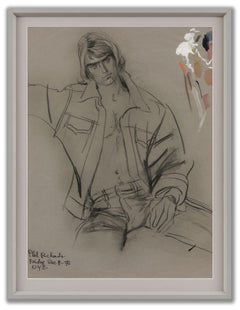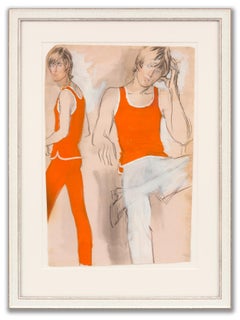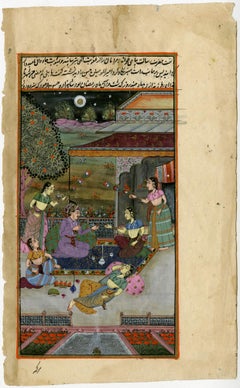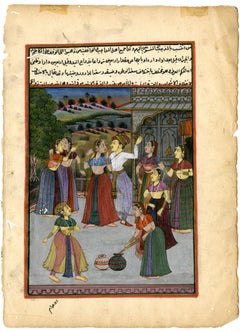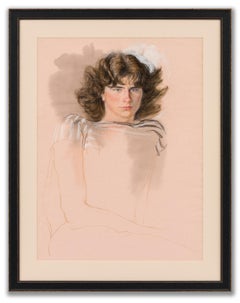Brian Stonehouse Art
British, 1918-1998
Brian Julian Warry Stonehouse was born in Torquay. He went to school in France before studying at Ipswich School of Art.
At the outbreak of World War II he was conscripted into the Royal Artillery. Because of his fluent French he joined Special Operations Executive and was parachuted into occupied France in July 1942. After several months of regular wireless transmissions back to Britain he was arrested by the Germans on 24 October 1942. After frequent brutal interrogations he was moved from concentration camp to concentration camp until he eventually arrived in Dachau where he was liberated by US troops on 29 April 1945. After the war he was able to testify at several war crimes trials.
In 1946 Stonehouse returned to his career as a fashion artist in the United States, drawing for magazines including Vogue, Harper’s Bazaar and Elizabeth Arden. In 1979 he returned to Britain where, in addition to his fashion illustrations, he became a portrait painter whose sitters included several members of the Royal Family.
(Biography provided by Sarah Colegrave Fine Art)
to
2
2
2
2
Overall Height
to
Overall Width
to
2
2
1
1
1
1
1
2
2
2
6,977
3,346
2,513
1,213
2
2
2
2
2
Artist: Brian Stonehouse
Phil Richards
By Brian Stonehouse
Located in London, GB
Charcoal and gouache on paper, titled ‘Phil Richards’ and dated ‘Friday Dec 8 72’ (lower left), 64cm x 48cm (72cm x 56cm framed).(Provenance: the Artist’s estate (stamped verso)). the picture is framed behind UV glass
Stonehouse had an extraordinary life. As a young art student studying fashion illustration, he joined the Royal Artillery at the beginning of WWII but soon became a part of the Special Operations Executive (SOE). He was sent to France as a radio operator but three and a half months later was caught by the Gestapo, tortured, given a death sentence and then selected for slave labour. He spent the subsequent war years in three French prisons and five concentration and labour camps, including Dachau. He still managed to continue to draw in some of the camps. Following the war, Stonehouse went to the US and continued his career as a fashion artist painting for magazines like Vogue, Harper's Bazaar and Elizabeth Arden. He was also an accomplished portraitist. His work is celebrated in Brian Stonehouse...
Category
1970s Post-War Brian Stonehouse Art
Materials
Paper, Charcoal, Gouache
Orange Vests
By Brian Stonehouse
Located in London, GB
Gouache and charcoal on paper, 53cm x 37cm (74cm x 55cm framed). Provenance: the Artist’s estate (stamped verso).
Stonehouse had an extraordinary life. As a young art student studying fashion illustration, he joined the Royal Artillery at the beginning of WWII but soon became a part of the Special Operations Executive (SOE). He was sent to France as a radio operator but three and a half months later was caught by the Gestapo, tortured, given a death sentence and then selected for slave labour. He spent the subsequent war years in three French prisons and five concentration and labour camps, including Dachau. He still managed to continue to draw in some of the camps. Following the war, Stonehouse went to the US and continued his career as a fashion artist painting for magazines...
Category
1970s Post-War Brian Stonehouse Art
Materials
Paper, Gouache, Charcoal
Related Items
Mughal School, 18th century Emperor Jahangir taking tea in his harem
Located in Middletown, NY
An illuminated page from a book likely in reference to palace life during Emperor Jahangir's reign over the Mughal Empire.
circa 1750. Gouache and ink with heightening in gold on li...
Category
18th Century Rajput Brian Stonehouse Art
Materials
Gold
Mughal School, 18th century – Emperor Jahangir dancing with his harem attendees
Located in Middletown, NY
A joyful scene of lighthearted merriment in the palace of Jangahir Mahal Agra
Circa 1750. Gouache and ink with gold heightening on light weight cream laid paper, 8 1/4 x 6 inches (2...
Category
18th Century Rajput Brian Stonehouse Art
Materials
Gold
Mughal School, 18th Century Emperor Jahangir with Empress Nur Jahan
Located in Middletown, NY
Emperor Jahangir and Empress Nur Jahan exchanging lotus blossoms; a symbol of beauty, purity, honesty, rebirth, self-regeneration, and enlightenment....
Category
18th Century Rajput Brian Stonehouse Art
Materials
Gold
Odalisque, Watercolour of a Female Nude
Located in Cotignac, FR
Late 20th Century watercolour on paper of a naked female figure before an open window. Signed bottom right but as yet not deciphered. Presented in carved, white painted wood frame.
...
Category
Late 20th Century Modern Brian Stonehouse Art
Materials
Paper, Watercolor, Gouache
Mughal School, 18th century Emperor Jahangir with Empress Nur Jahan & concubine
Located in Middletown, NY
An illuminated page from a book likely in reference to palace life during Emperor Jahangir's reign over the Mughal Empire.
circa 1750. Gouache and ink with heightening in gold on li...
Category
17th Century Rajput Brian Stonehouse Art
Materials
Gold
Dibujo a la manera de Velasquez (Drawing in the Manner of Velasquez)
By Fernando Botero
Located in Palm Desert, CA
A drawing by Fernando Botero. "Dibujo a la Manera de Velasquez" is a portrait, charcoal and pastel on cardboard in an earth-tone palette by Latin American artist Fernando Botero. It is signed upper right, "Sobre Velazquez Botero -1-27-60 Para Rita. el recuerdo de uno payaso".
Fernando Botero, best known for his voluptuously rotund human figures, was born in Medellín, Colombia on April 19, 1932. His father died when he was young, and he was raised by his mother, along with his two brothers. He attended a Jesuit school in Medellín and from the age of 12 to 14, he attended a matador training school. The bull fight became a recurring theme in Botero’s early work and while he was in his early teens, he sold his pictures of bull fights in front of the arena.
By the time he was 16 years of age, Botero was working as an illustrator for the local magazine El Colombiano. He also began writing articles about art theory, one of which, entitled Picasso and Non-Conformity in Art, led to his expulsion from the Jesuit school for its endorsement of Cubism. One of Botero’s important early works, Woman Crying...
Category
Mid-20th Century Post-War Brian Stonehouse Art
Materials
Charcoal, Pastel, Cardboard
MB 804 A&B (Double Sided Figurative Drawing, Two Male Nudes and Safari Hunter)
By Mark Beard
Located in Hudson, NY
Figurative drawing with graphite, charcoal, and conte crayon on Arches paper
30 x 19 inches, unframed
One piece of 30 x 19 inch Arches paper. Two drawings on opposite sides.
These u...
Category
2010s Modern Brian Stonehouse Art
Materials
Charcoal, Archival Paper, Graphite, Watercolor
'Bacchanal', Mid-century Pompeii, Roman Mythology, Bacchus, Neo-classical
By Giovanni Gallo
Located in Santa Cruz, CA
Signed lower right, 'Gallo Giovanni' for Giovanni Gallo (Italian, 20th century) and dated 1954.
Titled lower left, 'Eseguito a Pompei, 'Trionfo di Bacco'' (Done in Pompeii, 'Triumph of Bacchus...
Category
1950s Brian Stonehouse Art
Materials
Paper, Gouache
Nude - XXI Century, Contemporary Gouache and Charcoal Figurative Drawing, Female
By Marta Łebek
Located in Warsaw, PL
Marta Lebek is a Polish artist born in 1978. She currently lives and works in Spain.
She studied at the School of Fine Arts and specialized in the departm...
Category
21st Century and Contemporary Expressionist Brian Stonehouse Art
Materials
Paper, Charcoal, Gouache
Giuseppe Migneco(Italian painter) - 20th century figure drawing - Fortune teller
Located in Varmo, IT
Giuseppe Migneco (Messina 1903 - Milan 1997) - The fortune teller.
49.5 x 39.5 cm without frame, 52.5 x 40.5 cm with frame.
Antique mixed technique drawing on paper, in wooden fram...
Category
Mid-20th Century Post-War Brian Stonehouse Art
Materials
Mixed Media, Paper
Free Shipping
H 20.67 in W 15.95 in
'The Artist in her Studio', Paris, Académie de la Grande Chaumière, Geneva
Located in Santa Cruz, CA
Signed lower left, 'Marguerite Bordet' (French, 1909-2014) and painted circa 1965.
From an early age, Marguerite Bordet avidly pursued both drawing and painting. In the late 1930's and early '40s, she attended the Académie de la Grande Chaumière in Paris where she studied with the sculptor, Antoniucci Volti (Italian, 1915-1989). After several years, and feeling increasingly disconnected with the academic atmosphere of the Salon, she left to develop her independent artistic style.
Bordet's first public exhibition took place at the Galerie Claude (1947) and, for the next forty years, she continued to exhibit widely with success, both throughout France and internationally, including in Cairo (1955), Geneva (1960) and the United States (1966). A 1962 exhibition of her work showed a thematic rejection of the Academy's influence and the artist's shift to a more personal and spiritually driven style.
Bordet continued to take frequent study trips to Italy, especially to Florence, where she was inspired by the Renaissance Masters. She also visited England (1975-76) where the works of J.M.W.Turner and John Martin at the Tate Museum had a pronounced impact on her development.
In an interview with Hervé Serane, Marguerite Bordet described her artistic process in these words:
"I start my painting with spots. Sometimes I cover it completely and everything is dark. But then it's stronger than me, I can't bear that there isn't an opening. Immediately, I place a Light. I need the shadow to bring out the Light. So I start with the shadow to create this Light. I cannot define why I need this Light so much. It's stronger than me. It's something that dominates me without my being able to explain it intellectually. It is for me an absolute necessity to seek the Light in the darkness.. You have to open like you open a window. You have to reveal. I remove the stains that obscure my painting to find the luminous background of the canvas.... I only paint with transparent colors and I apply several layers of glaze to preserve this light."
Partial Exhibition Record:
1947 Paris, Galerie Claude
1951 Paris, Galerie Breteau - Cairo, Galerie Adam - Alexandria, l'Atelier
1954 Paris, Galerie Simone Bdinier
1955 Cairo, l'Atelier
1959 Paris, Galerie A. Weil
1960 Geneva, Galerie Motte
1962 Paris, Marignan Gallery
1964 Paris, Ror Volmar Gallery
1966 San Rafael (U.SA) International Museum
1966 Cagnes-sur-Mer, Castle Gallery...
Category
1960s Brian Stonehouse Art
Materials
Paper, Gouache, Graphite
H 25.5 in W 20 in D 0.13 in
Mughal School, 17th century – Emperor Jahangir reclining in his harem
Located in Middletown, NY
An illuminated page from a book likely in reference to palace life during Emperor Jahangir's reign over the Mughal Empire.
Circa 1690. Gouache and ink with gold heightening on light...
Category
18th Century Rajput Brian Stonehouse Art
Materials
Gold
Previously Available Items
Swimming Trunks
By Brian Stonehouse
Located in London, GB
Pastel and coloured chalks on paper, dated and marked ‘Ralph’ (upper left), 75cm x 55cm (79cm x 60cm framed). (Provenance; the artist’s estate, stamped verso). the picture is framed behind UV glass
Stonehouse had an extraordinary life. As a young art student studying fashion illustration, he joined the Royal Artillery at the beginning of WWII but soon became a part of the Special Operations Executive (SOE). He was sent to France as a radio operator but three and a half months later was caught by the Gestapo, tortured, given a death sentence and then selected for slave labour. He spent the subsequent war years in three French prisons and five concentration and labour camps, including Dachau. He still managed to continue to draw in some of the camps. Following the war, Stonehouse went to the US and continued his career as a fashion artist painting for magazines like Vogue, Harper's Bazaar and Elizabeth Arden. He was also an accomplished portraitist. His work is celebrated in Brian Stonehouse...
Category
1980s Post-War Brian Stonehouse Art
Materials
Paper, Chalk, Pastel
Portrait of a Young Man
By Brian Stonehouse
Located in London, GB
Pastel, charcoal, watercolour and gouache on paper, 62cm x 48cm (77cm x 60cm framed), Provenance: the Artist’s estate.
Stonehouse had an extraordinary life. As a young art student studying fashion illustration, he joined the Royal Artillery at the beginning of WWII but soon became a part of the Special Operations Executive (SOE). He was sent to France as a radio operator but three and a half months later was caught by the Gestapo, tortured, given a death sentence and then selected for slave labour. He spent the subsequent war years in three French prisons and five concentration and labour camps, including Dachau. He still managed to continue to draw in some of the camps. Following the war, Stonehouse went to the US and continued his career as a fashion artist painting for magazines...
Category
1970s Post-War Brian Stonehouse Art
Materials
Paper, Chalk, Watercolor, Pastel, Gouache
Brian Stonehouse art for sale on 1stDibs.
Find a wide variety of authentic Brian Stonehouse art available for sale on 1stDibs. You can also browse by medium to find art by Brian Stonehouse in charcoal, gouache, paint and more. Much of the original work by this artist or collective was created during the 1970s and is mostly associated with the post-war style. Not every interior allows for large Brian Stonehouse art, so small editions measuring 22 inches across are available. Brian Stonehouse art prices can differ depending upon medium, time period and other attributes. On 1stDibs, the price for these items starts at $1,920 and tops out at $2,548, while the average work can sell for $2,234.
